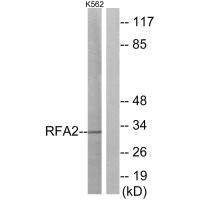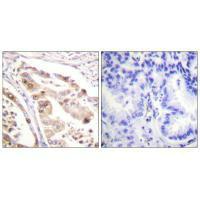
Western blot analysis of extracts from K562 cells, using RFA2 (Ab-21) antibody.
RPA2 (Ab-21) Antibody
CSB-PA086465
ApplicationsWestern Blot, ELISA, ImmunoHistoChemistry
Product group Antibodies
ReactivityHuman, Mouse
TargetRPA2
Overview
- SupplierCusabio
- Product NameRPA2 (Ab-21) Antibody
- Delivery Days Customer20
- ApplicationsWestern Blot, ELISA, ImmunoHistoChemistry
- CertificationResearch Use Only
- ClonalityPolyclonal
- ConjugateUnconjugated
- Gene ID6118
- Target nameRPA2
- Target descriptionreplication protein A2
- Target synonymsREPA2; replication factor A protein 2; replication protein A 32 kDa subunit; replication protein A 34 kDa subunit; RF-A protein 2; RP-A p32; RP-A p34; RPA32
- HostRabbit
- IsotypeIgG
- Protein IDP15927
- Protein NameReplication protein A 32 kDa subunit
- Scientific DescriptionAs part of the heterotrimeric replication protein A complex (RPA/RP-A), binds and stabilizes single-stranded DNA intermediates, that form during DNA replication or upon DNA stress. It prevents their reannealing and in parallel, recruits and activates different proteins and complexes involved in DNA metabolism. Thereby, it plays an essential role both in DNA replication and the cellular response to DNA damage. In the cellular response to DNA damage the RPA complex controls DNA repair and DNA damage checkpoint activation. It is required for the recruitment of the DNA double-strand break repair factors RAD52 and RAD51 to chromatin in response to DNA damage. Also recruits to sites of DNA damage proteins like XPA and XPG that are involved in nucleotide excision repair and is required for this mechanism of DNA repair. Plays also a role in base excision repair (BER) probably through interaction with UNG. Through RFWD3 may activate CHEK1 and play a role in replication checkpoint control. Also recruits SMARCAL1/HARP which is involved in replication fork restart to sites of DNA damage. May also play a role in telomere maintenance. Erdile L.F., J. Biol. Chem. 265:3177-3182(1990). Gregory S.G., Nature 441:315-321(2006). Niu H., J. Biol. Chem. 272:12634-12641(1997). Cho J.M., Nucleic Acids Res. 28:3478-3485(2000)
- ReactivityHuman, Mouse
- Storage Instruction-20°C or -80°C
- UNSPSC12352203

